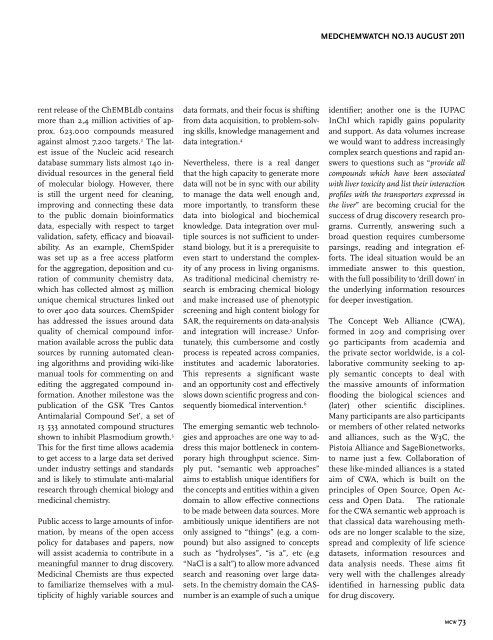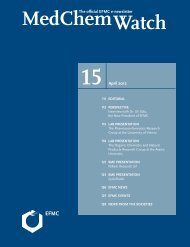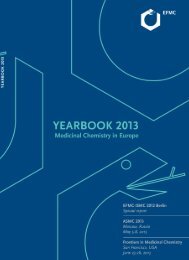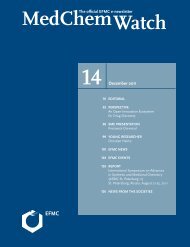Download MedChemWatch in PDF format - EFMC
Download MedChemWatch in PDF format - EFMC
Download MedChemWatch in PDF format - EFMC
Create successful ePaper yourself
Turn your PDF publications into a flip-book with our unique Google optimized e-Paper software.
MEDCHEMWATCH NO.13 AUGUST 2011<br />
rent release of the ChEMBLdb conta<strong>in</strong>s<br />
more than 2,4 million activities of approx.<br />
623.000 compounds measured<br />
aga<strong>in</strong>st almost 7.200 targets. 2 The latest<br />
issue of the Nucleic acid research<br />
database summary lists almost 140 <strong>in</strong>dividual<br />
resources <strong>in</strong> the general field<br />
of molecular biology. However, there<br />
is still the urgent need for clean<strong>in</strong>g,<br />
improv<strong>in</strong>g and connect<strong>in</strong>g these data<br />
to the public doma<strong>in</strong> bio<strong>in</strong><strong>format</strong>ics<br />
data, especially with respect to target<br />
validation, safety, efficacy and bioavailability.<br />
As an example, ChemSpider<br />
was set up as a free access platform<br />
for the aggregation, deposition and curation<br />
of community chemistry data,<br />
which has collected almost 25 million<br />
unique chemical structures l<strong>in</strong>ked out<br />
to over 400 data sources. ChemSpider<br />
has addressed the issues around data<br />
quality of chemical compound <strong>in</strong><strong>format</strong>ion<br />
available across the public data<br />
sources by runn<strong>in</strong>g automated clean<strong>in</strong>g<br />
algorithms and provid<strong>in</strong>g wiki-like<br />
manual tools for comment<strong>in</strong>g on and<br />
edit<strong>in</strong>g the aggregated compound <strong>in</strong><strong>format</strong>ion.<br />
Another milestone was the<br />
publication of the GSK ’Tres Cantos<br />
Antimalarial Compound Set’, a set of<br />
13 533 annotated compound structures<br />
shown to <strong>in</strong>hibit Plasmodium growth. 3<br />
This for the first time allows academia<br />
to get access to a large data set derived<br />
under <strong>in</strong>dustry sett<strong>in</strong>gs and standards<br />
and is likely to stimulate anti-malarial<br />
research through chemical biology and<br />
medic<strong>in</strong>al chemistry.<br />
Public access to large amounts of <strong>in</strong><strong>format</strong>ion,<br />
by means of the open access<br />
policy for databases and papers, now<br />
will assist academia to contribute <strong>in</strong> a<br />
mean<strong>in</strong>gful manner to drug discovery.<br />
Medic<strong>in</strong>al Chemists are thus expected<br />
to familiarize themselves with a multiplicity<br />
of highly variable sources and<br />
data <strong>format</strong>s, and their focus is shift<strong>in</strong>g<br />
from data acquisition, to problem-solv<strong>in</strong>g<br />
skills, knowledge management and<br />
data <strong>in</strong>tegration. 4<br />
Nevertheless, there is a real danger<br />
that the high capacity to generate more<br />
data will not be <strong>in</strong> sync with our ability<br />
to manage the data well enough and,<br />
more importantly, to transform these<br />
data <strong>in</strong>to biological and biochemical<br />
knowledge. Data <strong>in</strong>tegration over multiple<br />
sources is not sufficient to understand<br />
biology, but it is a prerequisite to<br />
even start to understand the complexity<br />
of any process <strong>in</strong> liv<strong>in</strong>g organisms.<br />
As traditional medic<strong>in</strong>al chemistry research<br />
is embrac<strong>in</strong>g chemical biology<br />
and make <strong>in</strong>creased use of phenotypic<br />
screen<strong>in</strong>g and high content biology for<br />
SAR, the requirements on data-analysis<br />
and <strong>in</strong>tegration will <strong>in</strong>crease. 5 Unfortunately,<br />
this cumbersome and costly<br />
process is repeated across companies,<br />
<strong>in</strong>stitutes and academic laboratories.<br />
This represents a significant waste<br />
and an opportunity cost and effectively<br />
slows down scientific progress and consequently<br />
biomedical <strong>in</strong>tervention. 6<br />
The emerg<strong>in</strong>g semantic web technologies<br />
and approaches are one way to address<br />
this major bottleneck <strong>in</strong> contemporary<br />
high throughput science. Simply<br />
put, “semantic web approaches”<br />
aims to establish unique identifiers for<br />
the concepts and entities with<strong>in</strong> a given<br />
doma<strong>in</strong> to allow effective connections<br />
to be made between data sources. More<br />
ambitiously unique identifiers are not<br />
only assigned to “th<strong>in</strong>gs” (e.g. a compound)<br />
but also assigned to concepts<br />
such as “hydrolyses”, “is a”, etc (e.g<br />
“NaCl is a salt”) to allow more advanced<br />
search and reason<strong>in</strong>g over large datasets.<br />
In the chemistry doma<strong>in</strong> the CASnumber<br />
is an example of such a unique<br />
identifier; another one is the IUPAC<br />
InChI which rapidly ga<strong>in</strong>s popularity<br />
and support. As data volumes <strong>in</strong>crease<br />
we would want to address <strong>in</strong>creas<strong>in</strong>gly<br />
complex search questions and rapid answers<br />
to questions such as “provide all<br />
compounds which have been associated<br />
with liver toxicity and list their <strong>in</strong>teraction<br />
profiles with the transporters expressed <strong>in</strong><br />
the liver” are becom<strong>in</strong>g crucial for the<br />
success of drug discovery research programs.<br />
Currently, answer<strong>in</strong>g such a<br />
broad question requires cumbersome<br />
pars<strong>in</strong>gs, read<strong>in</strong>g and <strong>in</strong>tegration efforts.<br />
The ideal situation would be an<br />
immediate answer to this question,<br />
with the full possibility to ‘drill down’ <strong>in</strong><br />
the underly<strong>in</strong>g <strong>in</strong><strong>format</strong>ion resources<br />
for deeper <strong>in</strong>vestigation.<br />
The Concept Web Alliance (CWA),<br />
formed <strong>in</strong> 209 and compris<strong>in</strong>g over<br />
90 participants from academia and<br />
the private sector worldwide, is a collaborative<br />
community seek<strong>in</strong>g to apply<br />
semantic concepts to deal with<br />
the massive amounts of <strong>in</strong><strong>format</strong>ion<br />
flood<strong>in</strong>g the biological sciences and<br />
(later) other scientific discipl<strong>in</strong>es.<br />
Many participants are also participants<br />
or members of other related networks<br />
and alliances, such as the W3C, the<br />
Pistoia Alliance and SageBionetworks,<br />
to name just a few. Collaboration of<br />
these like-m<strong>in</strong>ded alliances is a stated<br />
aim of CWA, which is built on the<br />
pr<strong>in</strong>ciples of Open Source, Open Access<br />
and Open Data. The rationale<br />
for the CWA semantic web approach is<br />
that classical data warehous<strong>in</strong>g methods<br />
are no longer scalable to the size,<br />
spread and complexity of life science<br />
datasets, <strong>in</strong><strong>format</strong>ion resources and<br />
data analysis needs. These aims fit<br />
very well with the challenges already<br />
identified <strong>in</strong> harness<strong>in</strong>g public data<br />
for drug discovery.<br />
MCW 73





